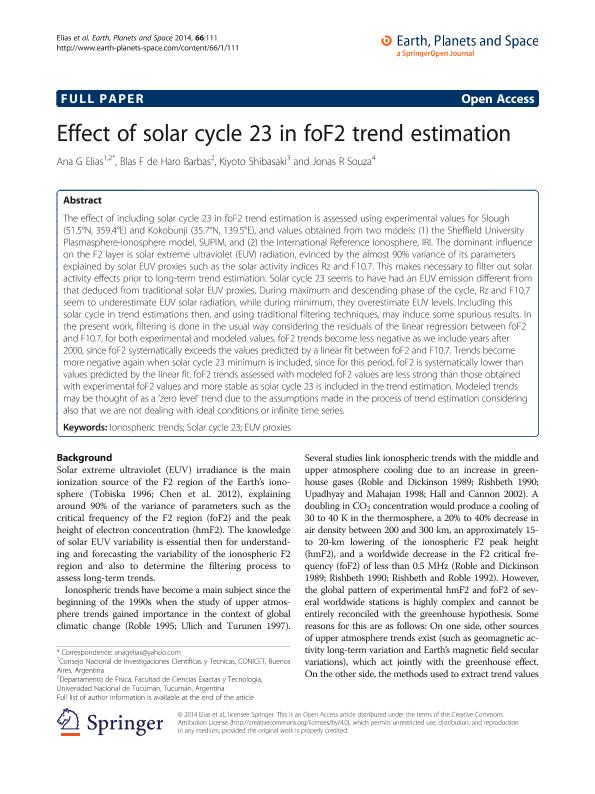Mostrar el registro sencillo del ítem
dc.contributor.author
Elias, Ana Georgina

dc.contributor.author
de Haro Barbás, Blas F.
dc.contributor.author
Shibasaki, Kiyoto
dc.contributor.author
Souza, Jonas R.
dc.date.available
2017-02-06T21:28:28Z
dc.date.issued
2014-09
dc.identifier.citation
Elias, Ana Georgina; de Haro Barbás, Blas F.; Shibasaki, Kiyoto ; Souza, Jonas R.; Effect of solar cycle 23 in foF2 trend estimation; Springer; Earth Planets And Space; 66; 111; 9-2014; 1-5
dc.identifier.uri
http://hdl.handle.net/11336/12585
dc.description.abstract
The effect of including solar cycle 23 in foF2 trend estimation is assessed using experimental values for Slough (51.5°N, 359.4°E) and Kokobunji (35.7°N, 139.5°E), and values obtained from two models: (1) the Sheffield University Plasmasphere-Ionosphere model, SUPIM, and (2) the International Reference Ionosphere, IRI. The dominant influence on the F2 layer is solar extreme ultraviolet (EUV) radiation, evinced by the almost 90% variance of its parameters explained by solar EUV proxies such as the solar activity indices Rz and F10.7. This makes necessary to filter out solar activity effects prior to long-term trend estimation. Solar cycle 23 seems to have had an EUV emission different from that deduced from traditional solar EUV proxies. During maximum and descending phase of the cycle, Rz and F10.7 seem to underestimate EUV solar radiation, while during minimum, they overestimate EUV levels. Including this solar cycle in trend estimations then, and using traditional filtering techniques, may induce some spurious results. In the present work, filtering is done in the usual way considering the residuals of the linear regression between foF2 and F10.7, for both experimental and modeled values. foF2 trends become less negative as we include years after 2000, since foF2 systematically exceeds the values predicted by a linear fit between foF2 and F10.7. Trends become more negative again when solar cycle 23 minimum is included, since for this period, foF2 is systematically lower than values predicted by the linear fit. foF2 trends assessed with modeled foF2 values are less strong than those obtained with experimental foF2 values and more stable as solar cycle 23 is included in the trend estimation. Modeled trends may be thought of as a ‘zero level’ trend due to the assumptions made in the process of trend estimation considering also that we are not dealing with ideal conditions or infinite time series.
dc.format
application/pdf
dc.language.iso
eng
dc.publisher
Springer

dc.rights
info:eu-repo/semantics/openAccess
dc.rights.uri
https://creativecommons.org/licenses/by-nc-sa/2.5/ar/
dc.subject
Ionospheric Trends
dc.subject
Solar Cycle 23
dc.subject
Euv Proxies
dc.subject.classification
Meteorología y Ciencias Atmosféricas

dc.subject.classification
Ciencias de la Tierra y relacionadas con el Medio Ambiente

dc.subject.classification
CIENCIAS NATURALES Y EXACTAS

dc.title
Effect of solar cycle 23 in foF2 trend estimation
dc.type
info:eu-repo/semantics/article
dc.type
info:ar-repo/semantics/artículo
dc.type
info:eu-repo/semantics/publishedVersion
dc.date.updated
2017-02-03T14:06:02Z
dc.identifier.eissn
1880-5981
dc.journal.volume
66
dc.journal.number
111
dc.journal.pagination
1-5
dc.journal.pais
Alemania

dc.journal.ciudad
Berlin
dc.description.fil
Fil: Elias, Ana Georgina. Universidad Nacional de Tucuman. Facultad de Ciencias Exactas y Tecnologia. Departamento de Fisica; Argentina. Consejo Nacional de Investigaciones Científicas y Técnicas; Argentina
dc.description.fil
Fil: de Haro Barbás, Blas F.. Universidad Nacional de Tucuman. Facultad de Ciencias Exactas y Tecnologia. Departamento de Fisica; Argentina
dc.description.fil
Fil: Shibasaki, Kiyoto . Nobeyama Solar Radio Observatory; Japón
dc.description.fil
Fil: Souza, Jonas R.. Centro de Previsao de Tempo E Estudos Climaticos. Instituto Nacional de Pesquisas Espaciais; Brasil
dc.journal.title
Earth Planets And Space

dc.relation.alternativeid
info:eu-repo/semantics/altIdentifier/url/https://earth-planets-space.springeropen.com/articles/10.1186/1880-5981-66-111
dc.relation.alternativeid
info:eu-repo/semantics/altIdentifier/url/http://link.springer.com/article/10.1186/1880-5981-66-111
dc.relation.alternativeid
info:eu-repo/semantics/altIdentifier/doi/http://dx.doi.org/10.1186/1880-5981-66-111
Archivos asociados
